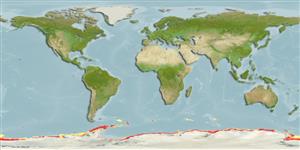Staurotheca compressa Briggs, 1938
| Native range | All suitable habitat | Point map | Year 2050 |

|
| This map was computer-generated and has not yet been reviewed. |
| Staurotheca compressa AquaMaps Data sources: GBIF OBIS |
Upload your photos
Google image |
No photo available for this species.No drawings available for Sertulariidae.
Google image |
No photo available for this species.
Classification / Names Common names | Synonyms | CoL | ITIS | WoRMS
Hydrozoa | Leptothecata | Sertulariidae
Environment: milieu / climate zone / depth range / distribution range Ecology
Benthic; depth range 45 - 1042 m (Ref. 7414). Polar
Distribution Countries | FAO areas | Ecosystems | Occurrences | Introductions
Circum-Antarctic.
Length at first maturity / Size / Weight / Age
Maturity: Lm ? range ? - ? cm Max length : 13.0 cm COLD male/unsexed; (Ref. 7414)
Short description Morphology
Colonies formed by a mass of stems and branches up to 13 cm in diameter. Branching frequent and irregular, with frequent anastomoses, giving the colony a compact appearance. Hydrothecae arranged in decussate pairs, forming four longitudinal rows. Hydrotheca small, with a small part immersed into the branch, cylindrical, more or less abcaudally directed. Adcauline hydrothecal wall adnate to internode for ca seven-eighths to one-half of its length. Free adcauline wall straight, or slightly concave or convex. Abcauline hydrothecal wall concave or straight. Hydrothecal aperture laterally depressed, resulting in the presence of both an adcauline and an abcauline cusp; the latter sometimes much better developed than the former. Hydrothecal diaphragm mushroom-shaped.
Life cycle and mating behavior Maturity | Reproduction | Spawning | Eggs | Fecundity | Larvae
Found in gonothecae in January, February and December. Fertile colonies were found in January to March and May to June.
Main reference
References | Coordinator | Collaborators
Peña Cantero, A.L. and W. Vervoort. 2003. (Ref. 7414)
IUCN Red List Status (Ref. 130435: Version 2024-1)
CITES status (Ref. 108899)
Not Evaluated
CMS (Ref. 116361)
Not Evaluated
Threat to humans
Harmless
Human uses
| FishSource |
Tools
More information
Trophic Ecology
Food items
Diet
Food consumption
Ration
Predators
Diet
Food consumption
Ration
Predators
Ecology
Population dynamics
Growth
Age/Size
Length-weight
Length-length
Length-frequencies
Mass conversion
Recruitment
Abundance
Age/Size
Length-weight
Length-length
Length-frequencies
Mass conversion
Recruitment
Abundance
Life cycle
Distribution
Human Related
Aquaculture profile
Stamps, Coins Misc.
Stamps, Coins Misc.
Outreach
Taxonomy
References
Internet sources
BHL | BOLD Systems | CISTI | DiscoverLife | FAO(Publication : search) | Fishipedia | GenBank (genome, nucleotide) | GloBI | Gomexsi | Google Books | Google Scholar | Google | PubMed | Tree of Life | Wikipedia (Go, Search) | Zoological Record
Estimates based on models
Preferred temperature
(Ref. 115969): -1.5 - 1.2, mean -0.5 (based on 306 cells).


